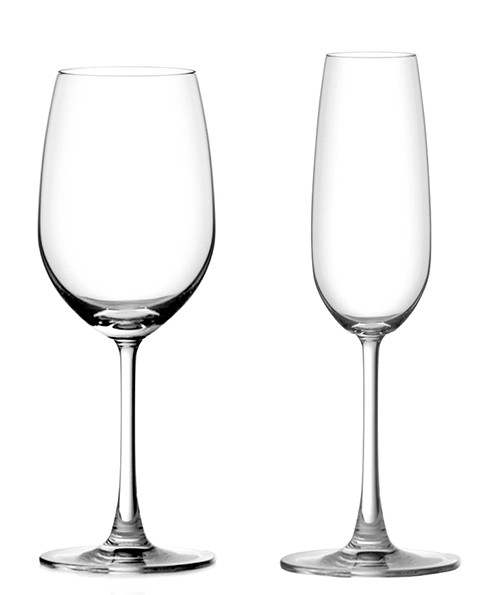
At a push, you could probably drink wine out of a plastic mug, but you’d lose most of the aroma and a good deal of the pleasure. Wine always tastes best out of a well-designed glass but they come in a bewildering variety of shapes and sizes. The distinguished Austrian firm of Riedel (REE-dull) was established in the same year that Mozart was born and it has revolutionized glassware by customizing the shape of wine glasses to a particular type of wine. There’s a range of glasses for Cabernet Sauvignon, another type for Shiraz, another for Riesling and so on. Wine expert Robert Parker considers them the finest available. “The effect of these glasses on fine wine is profound,” he writes, “I cannot emphasize enough what a difference they make.” But quality doesn’t come cheap. Even one of Riedel’s cheapest glasses can set you back 2,000 baht. And that’s just for one of them. Needless to say, these are products for wine professionals and top-class restaurants. Most of us usually have to settle for something a little more modest.
Even so, if you enjoy a variety of different wines you really need three or four different types of glass: (1) a medium-sized one for everyday plonk, (2) a larger one for quality wines, and (3) a tall one for sparkling wines. You can safely forget about serving white wine in a smaller glass, for a decently designed glass will do for both red and white. If you drink Sherry a small copita is a useful addition.
There are four main issues to consider: shape, comfort, transparency and size. You may also be concerned about price, so don’t buy glasses that you can’t afford to break. A tulip-shaped glass is best, because it concentrates the aroma near the rim. The glass should be well-balanced and not uncomfortably heavy, with a thin stem. The rim should be wide enough to get your nose inside. A plain, transparent glass is best because any form of colour or decoration is distracting. As to size, it rather depends on the quality of the wine. Regardless of size, I’d recommend the glasses produced by the Thai company Ocean Glass. It produces an extensive range of wine glasses which are good value and widely available.
For ordinary table wine the Ocean Duchess range is fine. The 255ml (9oz) red wine glass is 19cm (7.50 in) high and a pack of two is about 325 baht. If you crave something a bit more classy and money is no object, you might be interested in Ocean’s superb range of Lucaris crystal glasses, some of which are varietal specific.
Quality wines require larger glasses because you need to swirl the wine around to release the complex aroma. This is why the glass shouldn’t be more than about a third full. The Ocean 425ml (15oz) Madison red wine glass is a large elegant design standing at 22cm (8.6 in). I always use this for wine tasting and a pack of two costs around 325 baht. If you prefer something a little cheaper and more compact, Ocean’s Lexington range might meet your needs.
For sparkling wines you’ll need something different. Forget those absurd saucers-on-sticks that were once popular. They are useless for sparkling wine, or any wine for that matter. Far better is the glass known as a Champagne flute. It’s an elongated version of a standard glass and its extra height allows the bubbles to develop so you can feel their tingle on your tongue. Ocean’s elegant Madison Champagne flute is excellent. This 210ml (7.25oz) glass stands at 23cm (9 in) and it’s beautifully tapered to show a sparkler at its best. A pack of two is also about 325 baht.
But I must tell you that there’s one thing that I find intensely irritating. Well, there are several things actually, but the others can wait. It’s the sight of a person nonchalantly holding a wine glass by the bowl, as though cradling a mug of hot cocoa. You see, we should always hold our wine glass by the stem – ideally between the thumb and first two fingers. That’s what the stem is for. It is most definitely un-chic and socially taboo to grasp the glass by the bowl. Apart from that, the physical appearance of the wine provides information but not if your hand is covering the bowl and the glass is smeared with greasy fingerprints. The serving temperature is usually critical and if you insist on holding the bowl, the heat from your hand pushes up the wine’s temperature. You’d be surprised how rapidly this occurs. Greasy fingerprints also render the glasses more difficult to wash, and I speak from bitter experience.
At wine tastings, you sometimes see wine professionals holding the glass by the base, pinching it between the thumb and forefinger. This looks slightly odd but it keeps the hand as far as possible from the bowl. I sometimes find myself doing this but it’s rather impractical, because you have to use your other hand to put the glass down. Anyway, don’t let me catch you holding your glass by the bowl, or I shall send the dogs around to sort you out. Just don’t say you haven’t been warned.
 |
 |
 |





